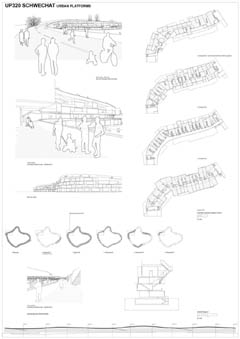SCHWECHAT
1. first prize: "urban platforms"
contributors: Mirko POGOREUTZ (D)
"The strength of the project lies in its urbanistic concept. Its scale reaches beyond the context and transforms the type of the urban block in such a way that its interior becomes an urban public landscape. The background framework of this landscape with its loop, i.e. a semi-public action loop on the roof, accentuates the character of the patio as an open urban zone, which is enriched by the activated remains of a brewery (function hall, brewhouse, chimney, etc.), landscape qualities and hedonistic equipment (e.g. a balustrade, a spiral, a sheep and the field of the 5 friends). Some members of the jury considered that the programs suggested were too arbitrary and too easily interchangeable, whereas others recognize the choice of the program as a very precise one regarding the typological strategy. In this sense it was also said that the road on the roof is a constituent part of the project which cannot be removed.
Points of criticism: the access to the road on the roof is not open enough; one can only get to it from outside from a small hill.
The representation of the housing type in the form of a loop was considered anachronistic by some jury members. Other members objected that the type had its own spatial and programmatic quality and that its scale created public openness and spheres of motion well separated from housing. By these means, value is added to housing. This added value has emancipated itself from the inner organization of the dwelling and consists independently of the prime functions of the individual dwellings (housing means more than cooking, sleeping, etc.).
The jury also discussed the question of the stepwise development: the jury does not share the city’s reservation. Several start scenarios are possible, be it implementation of a few small fragments as prototypes on the site, be it implementation of bigger fragments in a place of strategic importance for urban development. It is this gesture of the fragment that should outline the future development explicitly and anticipate the development of the realization steps yet to come. In this manner, the project disciplines and focuses the dynamism and allows a large scale which could provide to the city of Schwechat a significant unique landmark. The verbal reference to the brewery cellar should however be better formulated."
(Excerpt jury report)
"Die Stärke des Projektes liegt im städtebaulichen Konzept. Seine Größe bewegt sich außerhalb des kontextuellen Maßstabes und transformiert den Typus des städtischen Blocks, dessen Innenraum nunmehr einen urbanen, öffentlichen Landschaftsraum aufgespannt. Die hintergrundartige Rahmung dieses Landschaftsraumes durch den „Loop“ mit seiner (halb)öffentlichen Aktionsschleife auf dem Dach intensiviert den Charakter des Innenhofs als offene urbane Zone, die von den aktivierten Relikten der ehemaligen Brauerei (Feierhalle, Sudhaus, Schlot...), landschaftlichen Qualitäten und hedonistischen Einrichtungen (ZB Palustrade, Schnecke, Siedlungsschaf, 5-Freunde Feld) bevölkert ist. Ein Teil der Jury stuft die vorgeschlagenen Programme als zu willkürlich und austauschbar ein, während ein anderer Teil gerade die Wahl der Programme in Anbetracht der typologischen Strategie als durchaus präzise anerkennt. In diesem Sinne wird auch argumentiert, dass die Dachstraße konstituierender Bestandteil des Projektes ist und daher auch nicht wegfallen kann.
Kritisiert wird die zu wenig offene Zugänglichkeit der Dachstraße, die lediglich an einer Stelle von außen über eine topografische Erhebung betreten werden kann.
Die Darstellung der Wohnungstypus der Schleife wird von Teilen der Jury als anachronistisch eingestuft. Ein anderer Teil wendet jedoch ein, dass der Typus selbst eine räumliche und programmatische Qualität einbringt, deren Maßstab vom Wohnen losgelöste, öffentliche Frei- und Bewegungsräume schafft. Gerade damit wird dem Wohnen ein entscheidender Mehrwert gegeben. Dieser Mehrwert hat sich von der inneren Organisation der Wohnung emanzipiert und besteht unabhängig von den engeren Funktionen der einzelnen Wohnungen (Wohnen ist mehr als Kochen, Schlafen…).
Eingehend wird auch die Frage der stufenweisen Entwicklung diskutiert: die Bedenken der Stadt werden von der Jury hier nicht geteilt. So sind mehrere Anfangsszenarien denkbar, sei es die Errichtung mehrerer kleiner Fragmente an ausgesuchten „Teilstrecken“ am Grundstück, sei es die Platzierung eines größeren Fragments an einer für die urbane Entwicklung strategisch wichtigen Stelle. Gerade die Geste des Fragments soll die zukünftige Entwicklung explizit manifestieren und in der sichtbaren Vorwegnahme des noch nicht gebauten Gesamtprojektes die Entwicklung der nächsten Bauetappen animieren. Auf diese Weise „diszipliniert“ und bündelt das Projekt die vorhandenen Entwicklungsdynamiken und ermöglicht eine Großform, die der Stadt Schwechat einen signifikanten, einzigartigen Magneten verschaffen würde. Der nur verbal formulierte Bezug zu den Brauereikellern müsste allerdings stärker ausformuliert werden."
(Auszug Juryprotokoll)



